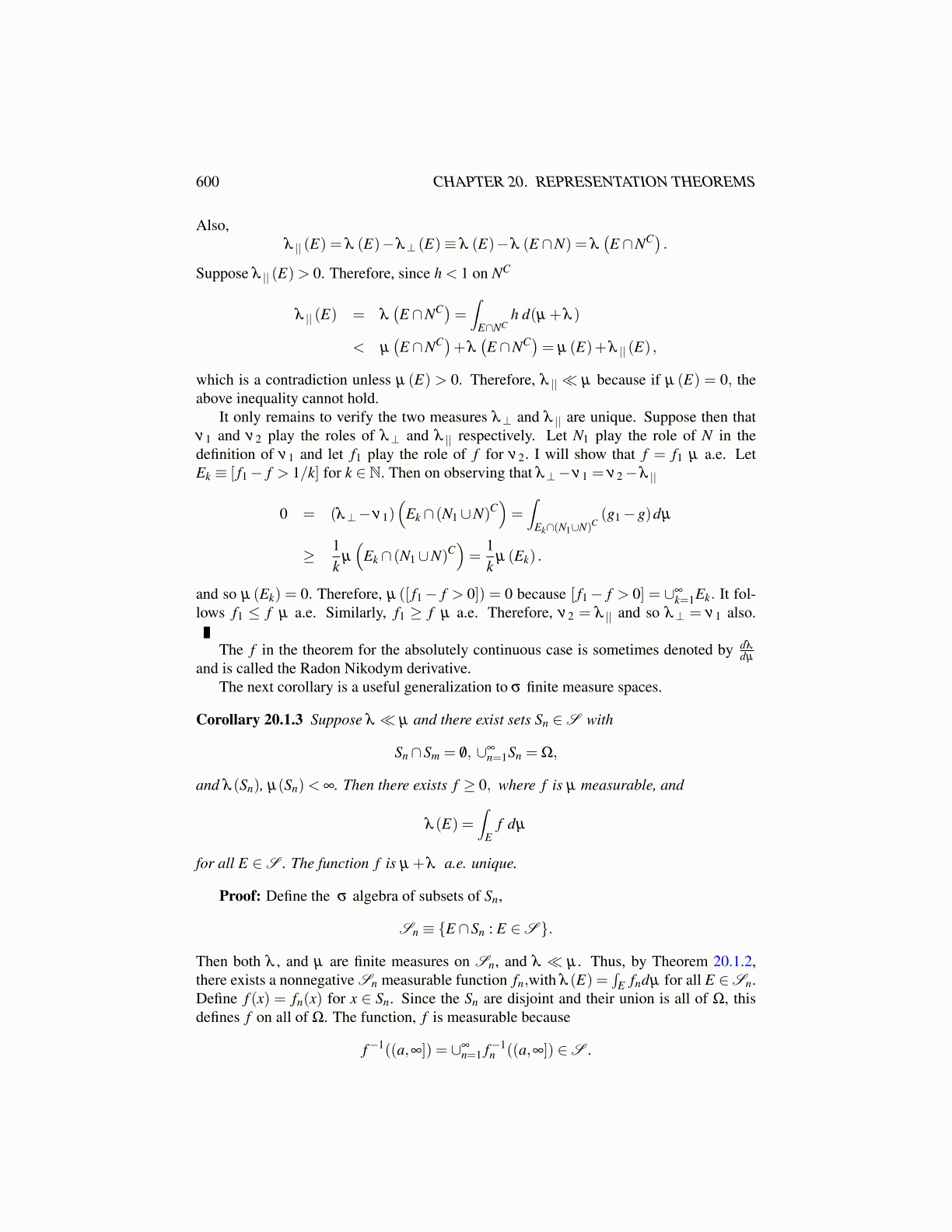
600 CHAPTER 20. REPRESENTATION THEOREMS
Also,λ || (E) = λ (E)−λ⊥ (E)≡ λ (E)−λ (E ∩N) = λ
(E ∩NC) .
Suppose λ || (E)> 0. Therefore, since h < 1 on NC
λ || (E) = λ(E ∩NC)= ∫
E∩NCh d(µ +λ )
< µ(E ∩NC)+λ
(E ∩NC)= µ (E)+λ || (E) ,
which is a contradiction unless µ (E) > 0. Therefore, λ || ≪ µ because if µ (E) = 0, theabove inequality cannot hold.
It only remains to verify the two measures λ⊥ and λ || are unique. Suppose then thatν1 and ν2 play the roles of λ⊥ and λ || respectively. Let N1 play the role of N in thedefinition of ν1 and let f1 play the role of f for ν2. I will show that f = f1 µ a.e. LetEk ≡ [ f1− f > 1/k] for k ∈ N. Then on observing that λ⊥−ν1 = ν2−λ ||
0 = (λ⊥−ν1)(
Ek ∩ (N1∪N)C)=∫
Ek∩(N1∪N)C(g1−g)dµ
≥ 1k
µ
(Ek ∩ (N1∪N)C
)=
1k
µ (Ek) .
and so µ (Ek) = 0. Therefore, µ ([ f1− f > 0]) = 0 because [ f1− f > 0] = ∪∞k=1Ek. It fol-
lows f1 ≤ f µ a.e. Similarly, f1 ≥ f µ a.e. Therefore, ν2 = λ || and so λ⊥ = ν1 also.
The f in the theorem for the absolutely continuous case is sometimes denoted by dλ
dµ
and is called the Radon Nikodym derivative.The next corollary is a useful generalization to σ finite measure spaces.
Corollary 20.1.3 Suppose λ ≪ µ and there exist sets Sn ∈S with
Sn∩Sm = /0, ∪∞n=1Sn = Ω,
and λ (Sn), µ(Sn)< ∞. Then there exists f ≥ 0, where f is µ measurable, and
λ (E) =∫
Ef dµ
for all E ∈S . The function f is µ +λ a.e. unique.
Proof: Define the σ algebra of subsets of Sn,
Sn ≡ {E ∩Sn : E ∈S }.
Then both λ , and µ are finite measures on Sn, and λ ≪ µ . Thus, by Theorem 20.1.2,there exists a nonnegative Sn measurable function fn,with λ (E) =
∫E fndµ for all E ∈Sn.
Define f (x) = fn(x) for x ∈ Sn. Since the Sn are disjoint and their union is all of Ω, thisdefines f on all of Ω. The function, f is measurable because
f−1((a,∞]) = ∪∞n=1 f−1
n ((a,∞]) ∈S .